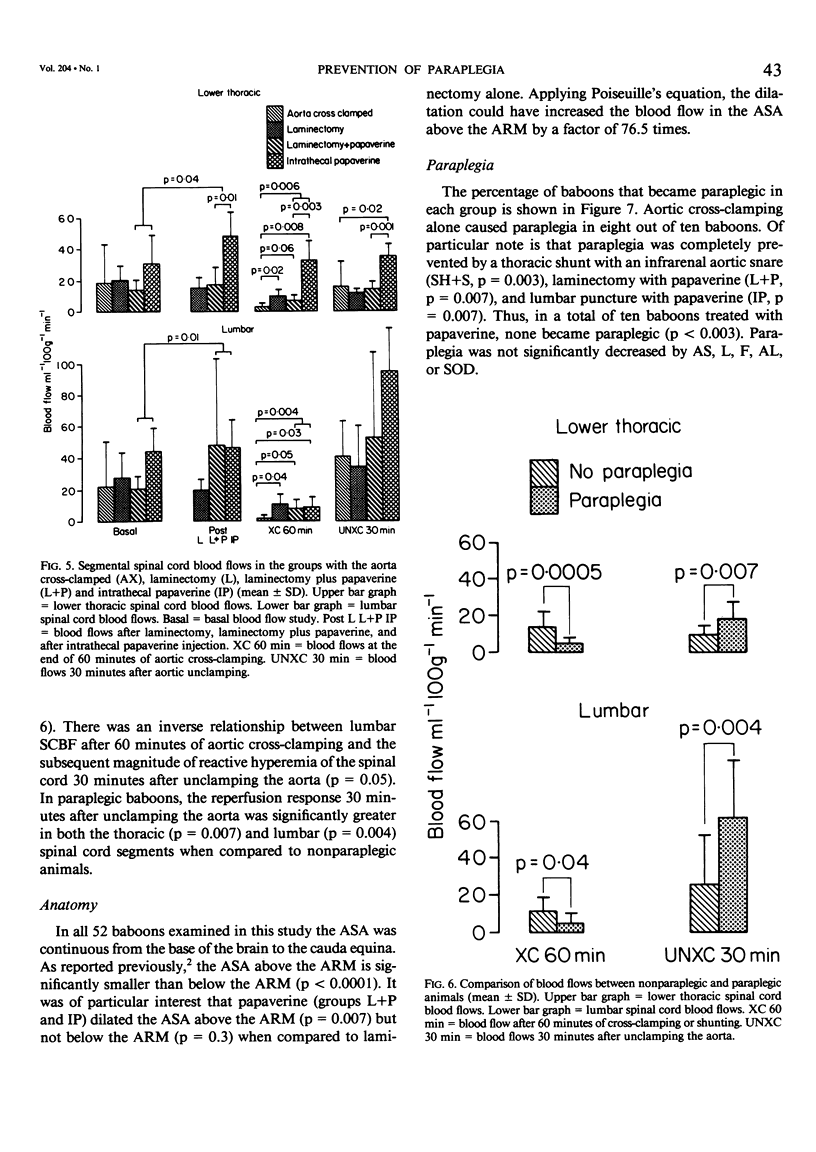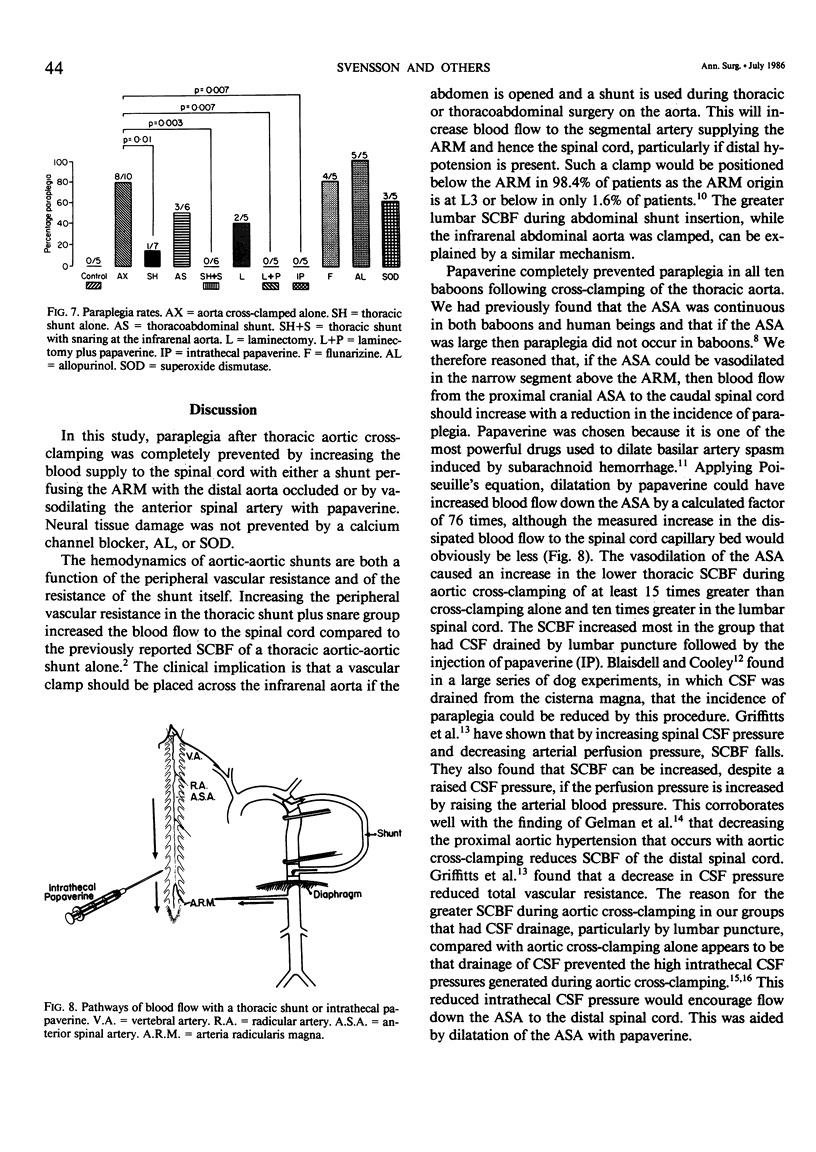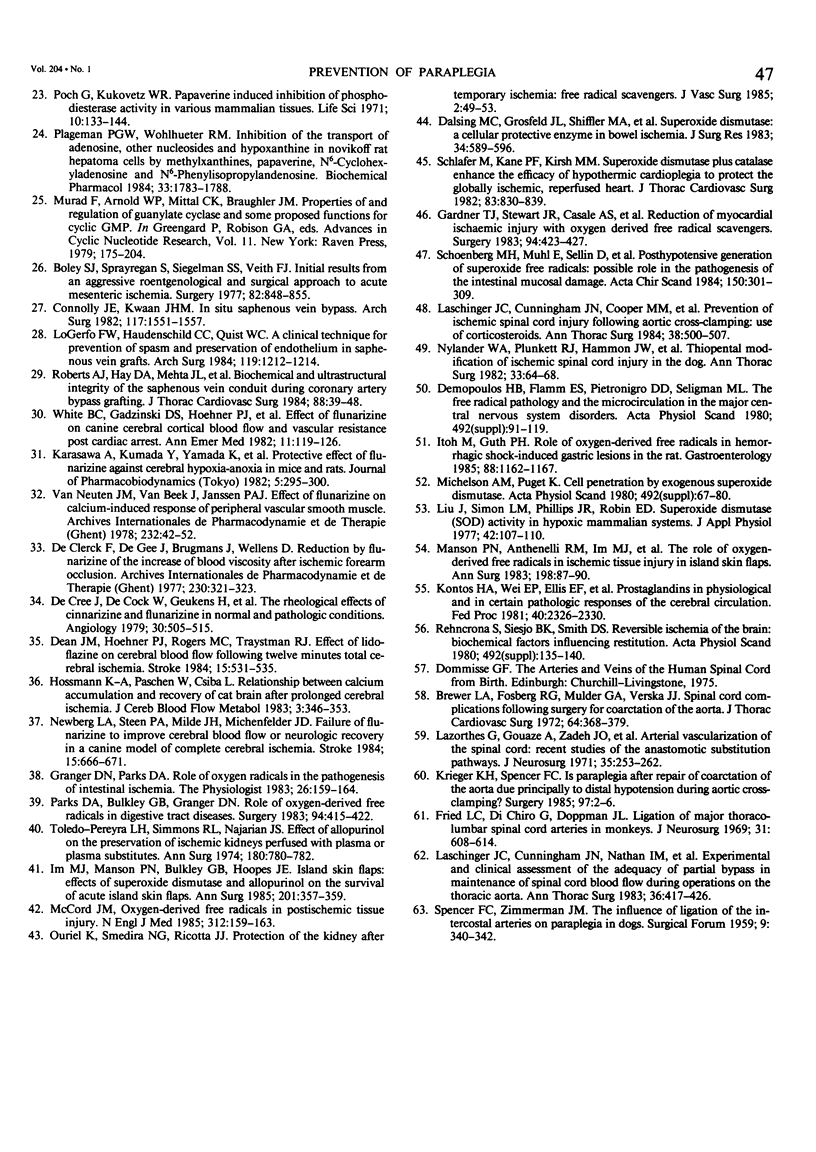Abstract
There is a high incidence of paraplegia associated with thoracic aortic cross-clamping, even when cardiopulmonary bypass or shunts are used. In 56 adult baboons, spinal cord blood flow (SCBF), vascular anatomy, and paraplegia rates were evaluated. Tissue blood flow was measured by radioactive microspheres. Various procedures were used to increase SCBF and to prevent ischemia-reperfusion injury. It was found that the rate of paraplegia was inversely correlated with neural tissue ischemia (SCBF) and directly correlated with reperfusion hyperemia. Two methods completely prevented paraplegia. These two methods were a thoracic shunt with occlusion of the infrarenal aorta or cerebrospinal fluid drainage plus intrathecal papaverine injection, both of which were associated with an increased SCBF. Furthermore, papaverine dilated the anterior spinal artery (ASA) (p = 0.007) and increased the blood flow through the lower ASA. Whereas procedures utilizing a calcium channel blocker (flunarizine), allopurinol, superoxide dismutase (SOD), laminectomy alone, and a thoracoabdominal shunt not perfusing the arteria radicularis magna (ARM) all failed to prevent paraplegia, allopurinol (p = 0.026) and SOD (p = 0.004) did prevent gastric stress lesions, indicating that their failure to prevent paraplegia was not due to a lack of activity. Of great clinical interest is that, if a shunt is used and the ARM is perfused, infrarenal aortic cross-clamping increases SCBF, thus preventing paraplegia. Intrathecal application of papaverine proved to be even more effective in increasing SCBF and also completely prevented paraplegia. As this is a safer procedure than the insertion of shunts, this is the method of choice for the prevention of paraplegia associated with thoracic aortic cross-clamping. The preliminary trial using intrathecal papaverine in human beings has thus far shown no adverse side effects from the drug, and no paraplegia has occurred.
Full text
PDF









Selected References
These references are in PubMed. This may not be the complete list of references from this article.
- Anderson D. K., Nicolosi G. R., Means E. D., Hartley L. E. Effects of laminectomy on spinal cord blood flow. J Neurosurg. 1978 Feb;48(2):232–238. doi: 10.3171/jns.1978.48.2.0232. [DOI] [PubMed] [Google Scholar]
- Appelbaum A., Karp R. B., Kirklin J. W. Surgical treatment for closed thoracic aortic injuries. J Thorac Cardiovasc Surg. 1976 Mar;71(3):458–460. [PubMed] [Google Scholar]
- BLAISDELL F. W., COOLEY D. A. The mechanism of paraplegia after temporary thoracic aortic occlusion and its relationship to spinal fluid pressure. Surgery. 1962 Mar;51:351–355. [PubMed] [Google Scholar]
- Bloodwell R. D., Hallman G. L., Cooley D. A. Partial cardiopulmonary bypass for pericardiectomy and resection of descending thoracic aortic aneurysms. Ann Thorac Surg. 1968 Jul;6(1):46–56. doi: 10.1016/s0003-4975(10)65989-9. [DOI] [PubMed] [Google Scholar]
- Boley S. J., Sprayregan S., Siegelman S. S., Veith F. J. Initial results from an agressive roentgenological and surgical approach to acute mesenteric ischemia. Surgery. 1977 Dec;82(6):848–855. [PubMed] [Google Scholar]
- Brewer L. A., 3rd, Fosburg R. G., Mulder G. A., Verska J. J. Spinal cord complications following surgery for coarctation of the aorta. A study of 66 cases. J Thorac Cardiovasc Surg. 1972 Sep;64(3):368–381. [PubMed] [Google Scholar]
- Connolly J. E., Kwaan J. H. In situ saphenous vein bypass. Arch Surg. 1982 Dec;117(12):1551–1557. doi: 10.1001/archsurg.1982.01380360027006. [DOI] [PubMed] [Google Scholar]
- Crawford E. S., Rubio P. A. Reappraisal of adjuncts to avoid ischemia in the treatment of aneurysms of descending thoracic aorta. J Thorac Cardiovasc Surg. 1973 Nov;66(5):693–704. [PubMed] [Google Scholar]
- Dalsing M. C., Grosfeld J. L., Shiffler M. A., Vane D. W., Hull M., Baehner R. L., Weber T. R. Superoxide dismutase: a cellular protective enzyme in bowel ischemia. J Surg Res. 1983 Jun;34(6):589–596. doi: 10.1016/0022-4804(83)90115-4. [DOI] [PubMed] [Google Scholar]
- De Clerck F., De Cree J., Brugmans J., Wellens D. Reduction by flunarizine of the increase of blood viscosity after ischemic forearm occlusion. Arch Int Pharmacodyn Ther. 1977 Dec;230(2):321–323. [PubMed] [Google Scholar]
- De Cree J., De Cock W., Geukens H., De Clerck F., Beerens M., Verhaegen H. The rheological effects of cinnarizine and flunarizine in normal and pathologic conditions. Angiology. 1979 Aug;30(8):505–515. doi: 10.1177/000331977903000801. [DOI] [PubMed] [Google Scholar]
- Dean J. M., Hoehner P. J., Rogers M. C., Traystman R. J. Effect of lidoflazine on cerebral blood flow following twelve minutes total cerebral ischemia. Stroke. 1984 May-Jun;15(3):531–535. doi: 10.1161/01.str.15.3.531. [DOI] [PubMed] [Google Scholar]
- Fried L. C., Di Chiro G., Doppman J. L. Ligation of major thoraco-lumbar spinal cord arteries in monkeys. J Neurosurg. 1969 Dec;31(6):608–614. doi: 10.3171/jns.1969.31.6.0608. [DOI] [PubMed] [Google Scholar]
- Gardner T. J., Stewart J. R., Casale A. S., Downey J. M., Chambers D. E. Reduction of myocardial ischemic injury with oxygen-derived free radical scavengers. Surgery. 1983 Sep;94(3):423–427. [PubMed] [Google Scholar]
- Gelman S., Reves J. G., Fowler K., Samuelson P. N., Lell W. A., Smith L. R. Regional blood flow during cross-clamping of the thoracic aorta and infusion of sodium nitroprusside. J Thorac Cardiovasc Surg. 1983 Feb;85(2):287–291. [PubMed] [Google Scholar]
- Gott V. L. Heparinized shunts for thoracic vascular operations. Ann Thorac Surg. 1972 Aug;14(2):219–220. doi: 10.1016/s0003-4975(10)65222-8. [DOI] [PubMed] [Google Scholar]
- Granger D. N., Parks D. A. Role of oxygen radicals in the pathogenesis of intestinal ischemia. Physiologist. 1983 Jun;26(3):159–164. [PubMed] [Google Scholar]
- Griffiths I. R., Pitts L. H., Crawford R. A., Trench J. G. Spinal cord compression and blood flow. I. The effect of raised cerebrospinal fluid pressure on spinal cord blood flow. Neurology. 1978 Nov;28(11):1145–1151. doi: 10.1212/wnl.28.11.1145. [DOI] [PubMed] [Google Scholar]
- Hantler C. B., Knight P. R. Intracranial hypertension following cross-clamping of the thoracic aorta. Anesthesiology. 1982 Feb;56(2):146–147. doi: 10.1097/00000542-198202000-00011. [DOI] [PubMed] [Google Scholar]
- Heymann M. A., Payne B. D., Hoffman J. I., Rudolph A. M. Blood flow measurements with radionuclide-labeled particles. Prog Cardiovasc Dis. 1977 Jul-Aug;20(1):55–79. doi: 10.1016/s0033-0620(77)80005-4. [DOI] [PubMed] [Google Scholar]
- Hossmann K. A., Paschen W., Csiba L. Relationship between calcium accumulation and recovery of cat brain after prolonged cerebral ischemia. J Cereb Blood Flow Metab. 1983 Sep;3(3):346–353. doi: 10.1038/jcbfm.1983.50. [DOI] [PubMed] [Google Scholar]
- Im M. J., Manson P. N., Bulkley G. B., Hoopes J. E. Effects of superoxide dismutase and allopurinol on the survival of acute island skin flaps. Ann Surg. 1985 Mar;201(3):357–359. doi: 10.1097/00000658-198503000-00018. [DOI] [PMC free article] [PubMed] [Google Scholar]
- Imai S., Kitagawa T. A comparison of the differential effects of nitroglycerin, nifedipine and papaverine on contractures induced in vascular and intestinal smooth muscle by potassium and lanthanum. Jpn J Pharmacol. 1981 Apr;31(2):193–199. doi: 10.1254/jjp.31.193. [DOI] [PubMed] [Google Scholar]
- Itoh M., Guth P. H. Role of oxygen-derived free radicals in hemorrhagic shock-induced gastric lesions in the rat. Gastroenterology. 1985 May;88(5 Pt 1):1162–1167. doi: 10.1016/s0016-5085(85)80075-5. [DOI] [PubMed] [Google Scholar]
- Karasawa A., Kumada Y., Yamada K., Shuto K., Nakamizo N. Protective effect of flunarizine against cerebral hypoxia-anoxia in mice and rats. J Pharmacobiodyn. 1982 Apr;5(4):295–300. doi: 10.1248/bpb1978.5.295. [DOI] [PubMed] [Google Scholar]
- Kontos H. A., Wei E. P., Ellis E. F., Dietrich W. D., Povlishock J. T. Prostaglandins in physiological and in certain pathological responses of the cerebral circulation. Fed Proc. 1981 Jun;40(8):2326–2330. [PubMed] [Google Scholar]
- Krieger K. H., Spencer F. C. Is paraplegia after repair of coarctation of the aorta due principally to distal hypotension during aortic cross-clamping? Surgery. 1985 Jan;97(1):2–7. [PubMed] [Google Scholar]
- Kukovetz W. R., Pöch G. Inhibition of cyclic-3',5'-nucleotide-phosphodiesterase as a possible mode of action of papaverine and similarly acting drugs. Naunyn Schmiedebergs Arch Pharmakol. 1970;267(2):189–194. doi: 10.1007/BF00999402. [DOI] [PubMed] [Google Scholar]
- Laschinger J. C., Cunningham J. N., Jr, Cooper M. M., Krieger K., Nathan I. M., Spencer F. C. Prevention of ischemic spinal cord injury following aortic cross-clamping: use of corticosteroids. Ann Thorac Surg. 1984 Nov;38(5):500–507. doi: 10.1016/s0003-4975(10)64192-6. [DOI] [PubMed] [Google Scholar]
- Laschinger J. C., Cunningham J. N., Jr, Nathan I. M., Knopp E. A., Cooper M. M., Spencer F. C. Experimental and clinical assessment of the adequacy of partial bypass in maintenance of spinal cord blood flow during operations on the thoracic aorta. Ann Thorac Surg. 1983 Oct;36(4):417–426. doi: 10.1016/s0003-4975(10)60481-x. [DOI] [PubMed] [Google Scholar]
- Liu J., Simon L. M., Phillips J. R., Robin E. D. Superoxide dismutase (SOD) activity in hypoxic mammalian systems. J Appl Physiol Respir Environ Exerc Physiol. 1977 Jan;42(1):107–110. doi: 10.1152/jappl.1977.42.1.107. [DOI] [PubMed] [Google Scholar]
- Livesay J. J., Cooley D. A., Ventemiglia R. A., Montero C. G., Warrian R. K., Brown D. M., Duncan J. M. Surgical experience in descending thoracic aneurysmectomy with and without adjuncts to avoid ischemia. Ann Thorac Surg. 1985 Jan;39(1):37–46. doi: 10.1016/s0003-4975(10)62520-9. [DOI] [PubMed] [Google Scholar]
- LoGerfo F. W., Haudenschild C. C., Quist W. C. A clinical technique for prevention of spasm and preservation of endothelium in saphenous vein grafts. Arch Surg. 1984 Oct;119(10):1212–1214. doi: 10.1001/archsurg.1984.01390220086020. [DOI] [PubMed] [Google Scholar]
- Manson P. N., Anthenelli R. M., Im M. J., Bulkley G. B., Hoopes J. E. The role of oxygen-free radicals in ischemic tissue injury in island skin flaps. Ann Surg. 1983 Jul;198(1):87–90. doi: 10.1097/00000658-198307000-00017. [DOI] [PMC free article] [PubMed] [Google Scholar]
- McCord J. M. Oxygen-derived free radicals in postischemic tissue injury. N Engl J Med. 1985 Jan 17;312(3):159–163. doi: 10.1056/NEJM198501173120305. [DOI] [PubMed] [Google Scholar]
- Michelson A. M., Puget K. Cell penetration by exogenous superoxide dismutase. Acta Physiol Scand Suppl. 1980;492:67–80. [PubMed] [Google Scholar]
- Murad F., Arnold W. P., Mittal C. K., Braughler J. M. Properties and regulation of guanylate cyclase and some proposed functions for cyclic GMP. Adv Cyclic Nucleotide Res. 1979;11:175–204. [PubMed] [Google Scholar]
- Najafi H., Javid H., Hunter J., Serry C., Monson D. Descending aortic aneurysmectomy without adjuncts to avoid ischemia. Ann Thorac Surg. 1980 Oct;30(4):326–335. doi: 10.1016/s0003-4975(10)61269-6. [DOI] [PubMed] [Google Scholar]
- Newberg L. A., Steen P. A., Milde J. H., Michenfelder J. D. Failure of flunarizine to improve cerebral blood flow or neurologic recovery in a canine model of complete cerebral ischemia. Stroke. 1984 Jul-Aug;15(4):666–671. doi: 10.1161/01.str.15.4.666. [DOI] [PubMed] [Google Scholar]
- Nylander W. A., Jr, Plunkett R. J., Hammon J. W., Jr, Oldfield E. H., Meacham W. F. Thiopental modification of ischemic spinal cord injury in the dog. Ann Thorac Surg. 1982 Jan;33(1):64–68. doi: 10.1016/s0003-4975(10)63200-6. [DOI] [PubMed] [Google Scholar]
- Ogata M., Marshall B. M., Lougheed W. M. Observations on the effects of intrathecal papaverine in experimental vasospasm. J Neurosurg. 1973 Jan;38(1):20–25. doi: 10.3171/jns.1973.38.1.0020. [DOI] [PubMed] [Google Scholar]
- Ouriel K., Smedira N. G., Ricotta J. J. Protection of the kidney after temporary ischemia: free radical scavengers. J Vasc Surg. 1985 Jan;2(1):49–53. [PubMed] [Google Scholar]
- Parks D. A., Bulkley G. B., Granger D. N. Role of oxygen-derived free radicals in digestive tract diseases. Surgery. 1983 Sep;94(3):415–422. [PubMed] [Google Scholar]
- Plagemann P. G., Wohlhueter R. M. Inhibition of the transport of adenosine, other nucleosides and hypoxanthine in novikoff rat hepatoma cells by methylxanthines, papaverine, N6-cyclohexyladenosine and N6-phenylisopropyladenosine. Biochem Pharmacol. 1984 Jun 1;33(11):1783–1788. doi: 10.1016/0006-2952(84)90350-2. [DOI] [PubMed] [Google Scholar]
- Pöch G., Kukovetz W. R. Papaverine-induced inhibition of phosphodiesterase activity in various mammalian tissues. Life Sci I. 1971 Feb 1;10(3):133–144. doi: 10.1016/0024-3205(71)90086-5. [DOI] [PubMed] [Google Scholar]
- Rehncrona S., Siesjö B. K., Smith D. S. Reversible ischemia of the brain: biochemical factors influencing restitution. Acta Physiol Scand Suppl. 1980;492:135–140. [PubMed] [Google Scholar]
- Roberts A. J., Hay D. A., Mehta J. L., Mehta P., Roy L., Faro R. S., Knauf D. G., Alexander J. A. Biochemical and ultrastructural integrity of the saphenous vein conduit during coronary artery bypass grafting. Preliminary results of the effect of papaverine. J Thorac Cardiovasc Surg. 1984 Jul;88(1):39–48. [PubMed] [Google Scholar]
- SPENCER F. C., ZIMMERMAN J. M. The influence of ligation of intercostal arteries on paraplegia in dogs. Surg Forum. 1958;9:340–342. [PubMed] [Google Scholar]
- Schoenberg M. H., Muhl E., Sellin D., Younes M., Schildberg F. W., Haglund U. Posthypotensive generation of superoxide free radicals--possible role in the pathogenesis of the intestinal mucosal damage. Acta Chir Scand. 1984;150(4):301–309. [PubMed] [Google Scholar]
- Shlafer M., Kane P. F., Kirsh M. M. Superoxide dismutase plus catalase enhances the efficacy of hypothermic cardioplegia to protect the globally ischemic, reperfused heart. J Thorac Cardiovasc Surg. 1982 Jun;83(6):830–839. [PubMed] [Google Scholar]
- Svensson L. G., Antunes M. D., Kinsley R. H. Traumatic rupture of the thoracic aorta. A report of 14 cases and a review of the literature. S Afr Med J. 1985 May 25;67(21):853–857. [PubMed] [Google Scholar]
- Svensson L. G., Rickards E., Coull A., Rogers G., Fimmel C. J., Hinder R. A. Relationship of spinal cord blood flow to vascular anatomy during thoracic aortic cross-clamping and shunting. J Thorac Cardiovasc Surg. 1986 Jan;91(1):71–78. [PubMed] [Google Scholar]
- Toledo-Pereyra L. H., Simmons R. L., Najarian J. S. Effect of allopurinol on the preservation of ischemic kidneys perfused with plasma or plasma substitutes. Ann Surg. 1974 Nov;180(5):780–782. doi: 10.1097/00000658-197411000-00012. [DOI] [PMC free article] [PubMed] [Google Scholar]
- Tsuda S., Urakawa N., Fukami J. The inhibitory effect of papaverine on respiration-dependent contracture of giunea pig tainia coli in high-K medium. II. Inhibition of mitochondrial respiration. Jpn J Pharmacol. 1977 Dec;27(6):845–853. doi: 10.1254/jjp.27.845. [DOI] [PubMed] [Google Scholar]
- Van Nueten J. M., Van Beek J., Janssen P. A. Effect of flunarizine on calcium-induced responses of peripheral vascular smooth muscle. Arch Int Pharmacodyn Ther. 1978 Mar;232(1):42–52. [PubMed] [Google Scholar]
- Wadouh F., Lindemann E. M., Arndt C. F., Hetzer R., Borst H. G. The arteria radicularis magna anterior as a decisive factor influencing spinal cord damage during aortic occlusion. J Thorac Cardiovasc Surg. 1984 Jul;88(1):1–10. [PubMed] [Google Scholar]
- White B. C., Gadzinski D. S., Hoehner P. J., Krome C., Hoehner T., White J. D., Trombley J. H., Jr Effect of flunarizine on canine cerebral cortical blood flow and vascular resistance post cardiac arrest. Ann Emerg Med. 1982 Mar;11(3):119–126. doi: 10.1016/s0196-0644(82)80235-7. [DOI] [PubMed] [Google Scholar]
- de Bakey M. E., McCollum C. H., Graham J. M. Surgical treatment of aneurysms of the descending thoracic aorta: long-term results in 500 patients. J Cardiovasc Surg (Torino) 1978 Nov-Dec;19(6):571–576. [PubMed] [Google Scholar]


